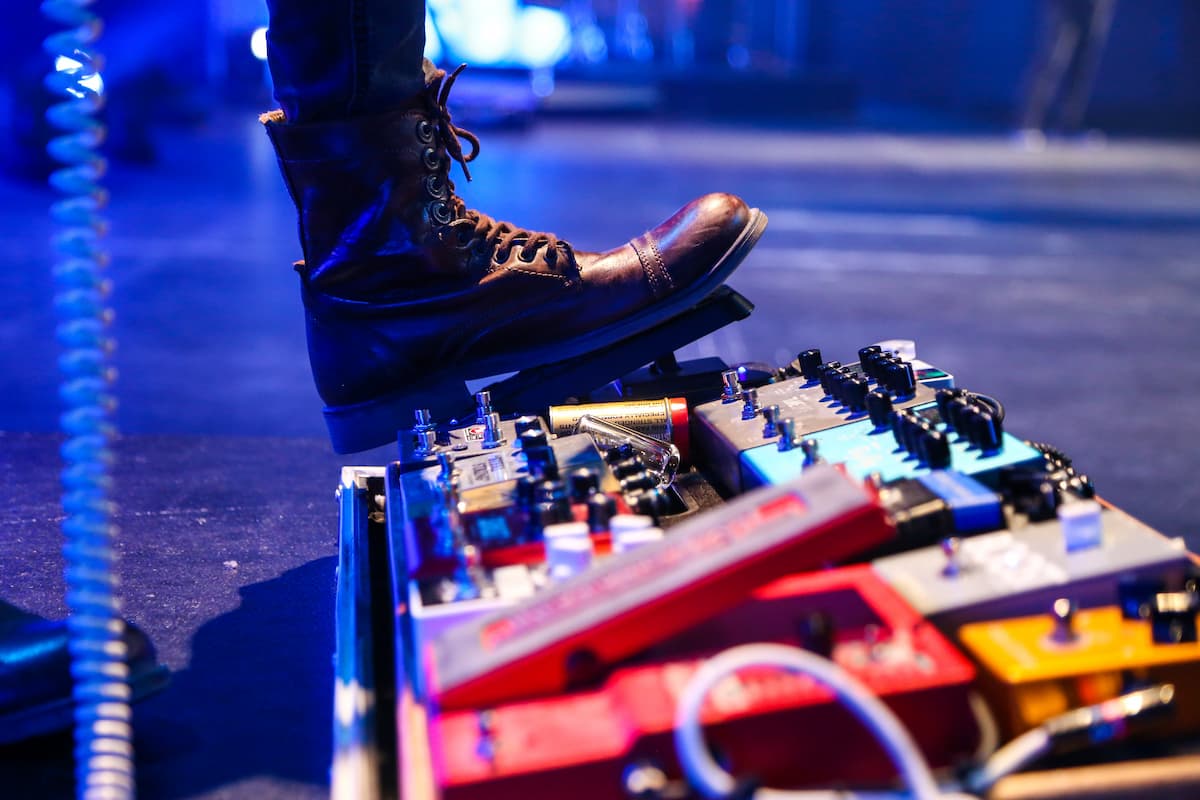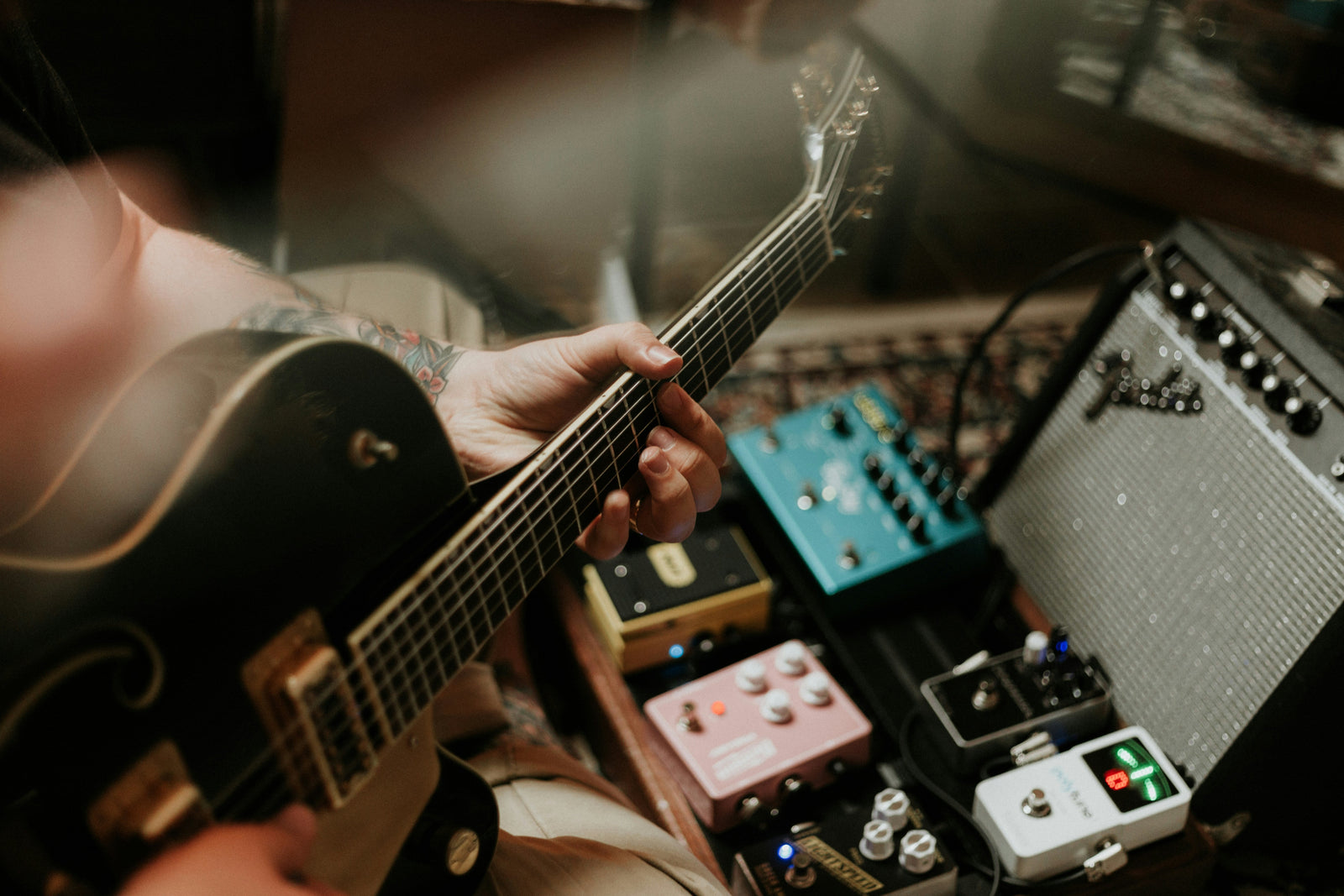We all know the phrase, "It's not what you know — it's who you know." It's a well-known saying in the business world that helps explain how people move up the ladder. Plus, how they make connections for their future. You can also connect this phrase to musicians and equipment. You aren't always guaranteed to get the best tone with your equipment. If someone knows how good your gear is, they'll try to get it from you at all costs.
Functionality and reliability characterize BOSS pedals. Its main users are musicians or audio engineers. They're the one who wants to start (or build) collectibles. A collection of good-sounding, reliable, and roadworthy pedals.
They are one of the most trusted brands because they have been around for ages and have withstood the test of time. They cater to all price ranges, build great products and come in a wide variety of models. Select what works best for your playing needs.

What are Tuners Effects Pedals?
If you are an electric guitar player, you are already familiar with guitar pedals. Many guitarists use these in conjunction with their amps, or even as a replacement for their amps. A pedal enables the player to change certain aspects of the sound of their playing. Such as volume and tone, and to also add different effects to it.
A tuner pedal will detect the pitch of the string being played on your electric guitar. Then it will be visible on the screen. The string then needs to be tuned until it matches the pitch shown on the screen. You may do this by moving the tuning keys on your guitar. Move until they are fully turned while keeping your eye on the pedal's display.
Why Should You Buy A Tuner Guitar Pedal?
Tuners are a key element of the audio and guitar industry. It allows people to keep their instruments in tune. These days, many different types of tuners and pedalboards are rising. They're designed to make your life easier when it comes to tuning your instrument.
The tuners are an integral part of any guitar player's kit. They're the devices that allow you to quickly and accurately tune your instruments after you've set up your guitar. This can help solve issues with intonation and make playing more enjoyable. While also helping you avoid damaging your instrument in the first place.
This is a great aid to the guitar player, as they take out a lot of the effort involved in tuning your guitar. Also, they help you play more accurately and maintain the proper intonation when playing at a high level. A tuner like this will make sure that your guitar stays in tune when you’re playing chords. Or picking single notes from one string to another.
How Does A Tuner Guitar Pedal Works?
A tuner guitar pedal works in a very different way from other guitar pedals. They take the form of a small footswitch that is turned on when you want to tune your guitar. Then off again once done. When you turn it on and play a note, the tuner guitar pedal will point out the pitch and display it. You may do this by analyzing the frequency of the note. Then compare that to the correct pitch.
Watch this BOSS TU-3S Chromatic Tuner Pedal Demo with Tom Quayle to better understand how this tuning pedal works.
Tuner Guitar Pedal: Buying Guide
-
Light Display
The first thing that you may want to consider is the brightness of the lights. Most tuner pedals come with bright LEDs that are always on, so it is easy to see the display. But what if you are playing indoors in low-light conditions? You might have a hard time seeing the display. If that is the case, then you’ll need a high-quality tuner pedal with high-brightness LEDs. This is great for indoor gigs or outdoor gigs in daylight.
The brightness of the display indicates whether you are tuned correctly. This makes it much easier to determine whether you need to tune your strings or not.
-
Real-Time
The first factor is real-time responsiveness. This refers to your guitar pedal's ability to respond to pitch and allow you to adjust your tuning.
The responsiveness of a guitar pedal plays an important role at about any stage of the song. If your notes aren't in tune when playing, it can throw off your timing. Plus, make it more difficult to play rhythm guitar parts accurately. A good quality guitar pedal should have a quick response time. So you can tune up quickly between verses or even during your solo. Some pedals can react quickly and others may take a bit longer. If your pedal isn't performing this way, it may not be as enjoyable an experience for you.
BOSS Tuners Guitar Pedals
Top BOSS Tuners Guitar Pedals:TU-3W Chromatic Tuner
The TU-3W is the result of BOSS' 12 years of research and development in pedal tuning technology. Plus more than 80 years of experience tuning instruments. The only tuner that allows you to switch between "tuner" and "strobe" modes. BOSS designed this pedal for easy viewing on dark stages. Mode selection on the TU-3W is crucial to getting accurate readings. The TU-3W features the world's first Chromatic Tuner mode. It displays any note you play on a guitar or bass. This new Chromatic feature eliminates the guesswork. These are often associated with tuning one guitar to another using the traditional Guitar/Bass modes found in other tuners.
When you think something isn't quite right with how an instrument sounds, it's probably not your ear — it's your tuner! End errors and get back to playing with confidence. Tune one guitar to another or another instrument like a bass.
What are Utility Effects Pedals?
An essential part of any guitarist's setup, utility pedals have a specific function to help you with certain aspects of your playing. These effects pedals allow you to bring more musicality to your rig and add more options for sound. You can find many different uses for utility pedals like loopers, volume pedals, noise gates and tuners.
Utility effects pedals are hardware extensions of your guitar that do not affect the pitch. A good example of a utility effect pedal would be a volume pedal (as it does not change the tone). You can place utility pedals anywhere in your signal chain. This removes any need for you to change anything about your sound. Utility pedals come in different shapes and sizes as well as costs depending on what they do.
Why Should You Buy A Utility Guitar Pedal?
When you create music, the guitar is what makes it sound great. Although you can't improve the luster of a rose with your own hands. But, you can change it by applying different pedals to your instrument. Most guitar pedals also provide an interesting selection of tones and effects (which can be fun). Plus, they're convenient and compact.
How Does A Utility Guitar Pedal Works?
Utility Pedals are pedals that you can use for a variety of different tasks. They range from adding expression control to your sound (along with volume pedal changing). This allows you to manipulate your other effects via an EQ pedal. You can use this kind of pedal on almost any instrument. They're a great way to expand your setup on the fly or create new sounds.
It is something that you can use to take your rig to the next level. You can use some for volume control and some have expression pedals. Which sends different guitar rigs from one amp source to another. Or, if you want to add an effects loop with a real two-seater-like compact pedal board.
One example of the utility guitar pedal is the Noise Suppressor. Justin from Sonic Sense shows us the BOSS NS-2 Noise Suppressorguitar pedal.
Types of Utility Guitar Pedals
Guitar pedals are an integral part of modern-day music. Below are 7 types of guitar effects pedals. We added a brief description of each type so you can choose the best pedal for your needs.
-
Line Selector
If you are looking for a simple, effective, and easy-to-use effect processor and use a single-box effects configuration, Line Selector provides the best solution. It is a perfect device for multi-effect units. Or a guitar amplifier's multi-speaker applications.
The Line selector connects to an amplifier or mixer via a 1/4 jack and expands its capabilities. This allows you to switch different effects between the loop sources, turn the volume of each, change their order, and bypass them using any line-level source.
-
Noise Suppressor
Are you searching for a pedal that lets your guitar, bass, or other instruments play just the way you want them to? This is it. It's perfect for recording engineers, electronic musicians, and anyone who wants to shield their guitar or piano from unwanted noise and hum in the signal path.
Noise Suppressors are a great addition to any pedalboard, whether it's for live performances or recording. One of the most common problems that musicians have when using pedals is unwanted noise and hum. These can be bothersome, especially in situations where you're trying to get clean, quiet tones from your rig.
-
Slicer
A slicer is an effect that combines a modulation sequence with an envelope filter to create a percussive and rhythmical effect. It can be any sort of filter (sine, resonant, or noise), but usually has some kind of linear shape that varies over time. Unlike long-release delays and other types of long delays, the result is not gradual change—but rather "pulsing" changes in timbre.
It is an effects unit that is made to create percussive side-effect sounds. Unlike the phaser and tremolo, there's no changing speed or wave shape in Slicer: it just generates a rhythmic effect.
-
Synthesizer
A synth pedal will take your guitar solo into a whole new world, but often it's the guitar that leads the way. Some of the coolest tones imaginable have been created with synthesizers in mind and then harmonized with guitars.
When used on a guitar, synth pedals can produce some insane sounds. They can even come close to mimicking some guitar synths, but when applied to an acoustic tone produces something unique and interesting in their own right. Those looking for a way to add an extra dimension to their guitar sound will find the best synth pedals a useful tool in their arsenal.
-
Vocoder
Unlock the expressive range of your instrument's voice with the Vocoder. Using cutting-edge technology and a simple pedal design, this stompbox brings the best of human vocals to your music. Use it in your studio, onstage, or on the go to unleash a new way for your instrument to sing.
-
Multi-Effects Switcher
The Multi-Effects Switcher is a small, dedicated unit where you can free up space on your pedalboard by combining two effects in one convenient unit. Combining all your pedals into one, easy-to-use box maximizes your creative options by allowing you to easily switch between your favorite guitar effects at the push of a button.
-
Effects Switching System
A switching system allows a guitarist to select different combinations of pedals and effects for their guitar signal. This gives the guitarist ultimate control over their sound, allowing them to have full creative freedom.
The guitarist simply hits the appropriate footswitch to audition effects combinations and ultimately, what devices process the guitar signal. You can choose between different pedals for different sounds, as well as select and combine chains of effects pedals.
BOSS Utility Guitar Pedals
- LS-2 Line Selector
- NS-2 Noise Suppressor
- SL-2 Slicer
- SY-1 Synthesizer
- VO-1 Vocoder
- MS-3 Multi Effects Switcher
- ES-5 Effects Switching System
- ES-8 Effects Switching System
Top BOSS Utility Guitar Pedals:NS-2 Noise Suppressor
Noise and hum are a guitar player's bane. Whether it's from amplifiers, pedals, or any other electrical equipment in your setup, unwanted noise can ruin the signal you're looking for. Low hum can't be completely removed without completely altering your tone and is both unpleasant to listen to and also smooths out the note transitions.
If you're looking for a cool, versatile pedal to add to your collection, the NS-2 is one of the best options. From eliminating noise to helping tame that fuzz pedal. The multiple modes make the NS-2 so useful. Just use Threshold and Delay controls to tailor the gate to your needs.
What are Loop Station Effects Pedals?
Loop pedals are stompboxes that sit on the floor and record what you play. They're a great way to create a thick, polyphonic soundscape by layering your performances in any song. Most loopers are no bigger than other effects pedals, but some have enough memory to record for nearly an hour or more of jamming.
This allows musicians to record themselves playing, then add their performance to their loop to create dense, polyphonic sounds.
Loop pedals have changed the way we create music today by lowering the barrier of entry into multi-tracking and allowing musicians to create music with only the bare essentials - just their instruments and themselves!
Why Should You Buy A Loop Station Guitar Pedal?
A looper pedal is a piece of gear for musicians and singers who want to perform with pre-recorded tracks or live instruments. Loopers can record audio in a variety of ways, from multi-track loops to one-man-band trickery. The basic concept is simple enough: you record something, then play it back over and over again. You can step through the loop by hand or use a guitar pedal to control the speed or volume as you move through its course.
While loop pedals are often used in a live setting, they can also help musicians improve their skills by allowing them to record themselves playing a solo piece or jam session, then play it back in slow motion so they can focus on one particular section. This can facilitate performance practice and experimentation as well as songwriting, composition, and live performance.
How Does A Loop Station Guitar Pedal Work?
A loop station is an instrument guitar pedal that can sample and replay the audio. It is the most popular tool used in the creation of music that can easily be categorized as EDM. These loop pedals are a very diverse tool in the studio and when playing live because they allow a musician to create patterns or riffs in real-time.
What is a loop pedal? A loop pedal is used to record and loop or layer sections of music. You can easily imagine the sounds that a loop station guitar pedal can produce. It's like a high-tech tape recorder or digital music recording device because this allows you to record using several different effects and devices. You can then use the pedal to overdub your guitar solos and riffs - which means you can run your track over and over again to get exactly the effect that you want!
Let’s watch this video as BOSS shows how we can utilize the functions of a Loop Station guitar pedal.
Loop Station Guitar Pedal: Buying Guide
Before you buy a loop pedal, there are some things to consider. The type of music you play, the types of pedals you already have, and how serious you are about your music will all factor into the type of guitar pedal that will be right for you.
As you can see below, some of the qualities that vary between loop pedals include:
-
Recording capacity
If you're looking for a pedal to allow you to record a long take, then choose one that can save your looping file, will save a lot of time. Loop station pedals let you record notes and save them for later, perfect for practicing songs trying to replicate them, and in some cases, recreating drum beats from favorite songs.
Loop pedals can make a great introduction to the world of loop generation, but with comparably short recording time compared to dedicated digital mixers. They are designed for musicians on stage who only want to practice a few bars in the loop and play live.
-
Channels quantity
How many loop channels do you need in your looper pedal? If you're looking to record a single rhythm part, most single-channel pedals and multi-effects units should work fine. But what if you want to record multiple parts at the same time? Depending on the effect, it may be possible to handle those parts with a single channel. However, most players prefer having the ability to play and record two or more instruments on separate channels.
-
Functions available
There are loop pedals that allow you to record and repeat guitar parts on the fly. They'll let you layer sound atop sound and take practice to the next level. It's a lot of fun to play around with these looping pedals, adjusting the tempo down and trying to figure out what happens when you make the loop go in reverse.
-
Mono input
Of course, you can record the audio from your keyboard using a mono loop pedal and create stereo loops if you wish. However, it isn't necessary to use a stereo loop pedal if you are interested in a mono input. As mentioned above, most loop pedals have a mono input and will also support instruments that produce sound in mono.
BOSS Loop Station Guitar Pedals
Top BOSS Loop Station Guitar Pedals:RC-5 Loop Station
The BOSS RC-5 is the updated version of the immensely popular RC-3 Loop Station. While that pedal was a great option for looping, the new features in the RC-5 can take your looping to another level.
As guitar players, we sometimes forget that our pedals are connected to the same cable and that there is a limited amount of available real estate on your pedal board. This means that you will always want to consider what is the best use of your pedal board space. The BOSS RC-5 loop station has an unprecedented amount of power in a tiny package. The BOSS RC-5 loop station is a great-sounding looper at an affordable price. The RC-5 allows you to record hours of audio on its 32 MB memory while allowing you to combine up to three minutes of triple-tracked guitar playing into a single recording.
BOSS Tuners & Utility Guitar Pedal: Conclusion
BOSS certainly knows a thing or two about the electric guitar and has been manufacturing effects pedals for over 35 years. As well as creating quality guitar effects, including distortion and overdrive pedals, BOSS also produces a range of practical utility pedals including tuners and loopers.
If you're a guitar player then you must always have tuners and utility guitar pedals with you. There are pros and cons to this kind of pedal, but overall they are incredibly useful.








